We typically don’t associate cutting-edge technology with environmental sustainability. Technology often gets blamed for our current environmental predicament, from internal combustion engines to electronic waste. But it’s not the technology itself that’s to blame, just the application. In the right hands, technology can help the planet solve urgent problems.
The Internet of Things offers great examples. IoT devices allow aspects of society that used to operate independently and invisibly to participate in vast information-sharing networks. We all recognize the impact of smartphones. With devices like industrial sensors, the IoT now allows companies to track efficiency and productivity in ways that weren’t possible before.
From an environmental standpoint, that kind of oversight is exactly what the global economy needs to confront big problems like climate change. Every aspect of the economy will have to adapt to become more sustainable if we’re going to avoid serious disruptions moving forward. IoT devices make those kinds of impactful improvements possible by allowing processes to be monitored in great depth and detail. As companies study the reality of where, when, and how they use resources, they can engineer upgrades throughout.
“Clean” technologies, like wind-generated energy, helped avoid 189 million tons of carbon pollution in 2017. Smart technologies equipped with IoT connectivity can have an even broader impact — they offer applications in all aspects of life, industrial and otherwise. Here are some examples illustrating how the IoT can deliver big benefits in practical ways:
Minimize Idling for Heavy Equipment
When a vehicle idles, it wastes fuel and taxes the engine — effects multiplied on big trucks and heavy equipment. Minimizing idling helps reduce carbon emissions by limiting fuel consumption. That means it not only helps the planet, but it also helps equipment operators save significantly on fuel costs.
New York City has attempted to crack down on idling by instituting a bounty program. Citizens who see a vehicle idling for longer than the three minutes allowed by city ordinance can report the violation and receive a percentage of the fine levied against the operator. This program is novel, but it’s a reactive rather than proactive approach. “All governments should have stricter rules for idling on sites,” says Amit Rai, CEO of MachineMax, a wireless telematics company.
“We should also monitor and manage heavy machines on construction and mining sites. These machines generate a lot more CO2 than cars or trucks while idling,” Rai notes.
In fact, a large machine can burn one gallon of fuel per hour, on average, while idling, which may constitute up to 50 percent of all running time. Using connected devices to monitor when and where an engine is idling brings this problem into view. As a result, companies can strictly manage fuel consumption, abide by local idling laws, and leave a smaller environmental footprint.
Save the Bees to Promote Pollination
The entire agricultural system relies on bees to pollinate plants. Recent declines in bee populations have put the future of this system in jeopardy, and rising costs for beekeepers have exacerbated the problem. “More beekeepers closing down would be bad news for the world’s food supply because many crops, including apples, watermelon, cherries, and cucumbers, currently rely on commercially raised honey bee colonies for pollination,” explains Brittney Goodrich, an agricultural economist at Auburn University.
Scientists have begun studying this problem by placing IoT devices inside beehives. The devices track bees’ movement in and out of the hive, revealing important details about the colony’s health. Connected devices allow scientists to study bee health while allowing beekeepers to manage bee populations better. For instance, if there’s a problem within a hive needing attention, IoT sensors can send a notification.
In another application, sensors inside the hive can detect a common parasite blamed for killing bees. Thanks to the IoT, we have an unparalleled perspective on the health of these vital pollinators. Being able to monitor the lives of millions of bees from inside the hive will uncover countless insights to help us preserve the bee population and promote future pollination.
Maximize Agricultural Production
Industrial farming requires huge amounts of resources and produces surprising amounts of pollution. Yet with global populations rising, we need to grow more food than ever.
IoT sensors allow farmers to monitor plants up close at all times. Sensors can track the weather, humidity, amount of moisture in the soil, and countless other variables affecting production. When those sensors are connected to an integrated platform, as well as automatic controls on irrigation systems, farmers can minimize water usage while maximizing yield.
In addition to their use in crop management, IoT sensors can be placed on farm animals to monitor their health. “Globally, the farmers have started to realize that the IoT can be a driving force for increasing agricultural production in a cost-effective way,” says Mitesh Patel, digital marketing manager at STEMpedia, a STEM learning platform. The combination of accessibility and utility means that the IoT will become a fundamental part of tomorrow’s farms.
At a time when effective environmental solutions are overdue, the IoT provides a lot of them. Most significantly, it helps align the interests of businesses and environmentalists in meaningful ways. For that reason alone, it’s going to attract a lot of enthusiastic advocates.


















